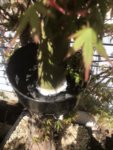amatbrewer
Shohin
I am going to preface this with the statement that I know this is not the best time to do this. However I want to know if A) it is feasible, and B) if doing so is likely to result in my learning enough to make it worth the effort.
I just acquired a Shishigashara (I love them and have wanted one for years) specifically to air layer a few sections off next spring. However while I have I have read a bit about it including the Bonsainut thread on air layering, and watched some videos, I have never performed air layering myself. So I was thinking of getting some practice by air layering a few branches of the red maples I have in my yard before I attempt it on the Shishigashara. I really, really don’t want to wait another year or more before getting to work on the Shishigashara if I can avoid it, so I would love to get some air layering experience this year if I can.
Were I to attempt to air layer the red maples now (Yakima is like “high desert” with hot days and cool to cold nights, and soon to be in the 90’s F or higher), is there reasonable chance it might work? And more importantly, would doing it be likely to provide me with some useful knowledge/experience, or would it be just a waste of time/materials?
If it helps I have been doing Bonsai since the late 80’s (I was a member of the San Diego Bonsai club, where I learned from some very talented and experienced people) but due to a number of events I had to get out of the hobby. I am only now getting back into it and trying to rebuild my collection. So I am not a novice, but I am out of practice and much of my knowledge/experience is probably very outdated.
I just acquired a Shishigashara (I love them and have wanted one for years) specifically to air layer a few sections off next spring. However while I have I have read a bit about it including the Bonsainut thread on air layering, and watched some videos, I have never performed air layering myself. So I was thinking of getting some practice by air layering a few branches of the red maples I have in my yard before I attempt it on the Shishigashara. I really, really don’t want to wait another year or more before getting to work on the Shishigashara if I can avoid it, so I would love to get some air layering experience this year if I can.
Were I to attempt to air layer the red maples now (Yakima is like “high desert” with hot days and cool to cold nights, and soon to be in the 90’s F or higher), is there reasonable chance it might work? And more importantly, would doing it be likely to provide me with some useful knowledge/experience, or would it be just a waste of time/materials?
If it helps I have been doing Bonsai since the late 80’s (I was a member of the San Diego Bonsai club, where I learned from some very talented and experienced people) but due to a number of events I had to get out of the hobby. I am only now getting back into it and trying to rebuild my collection. So I am not a novice, but I am out of practice and much of my knowledge/experience is probably very outdated.



